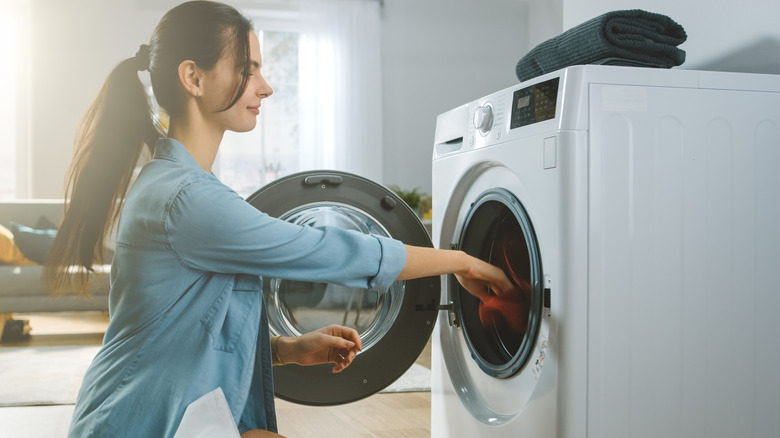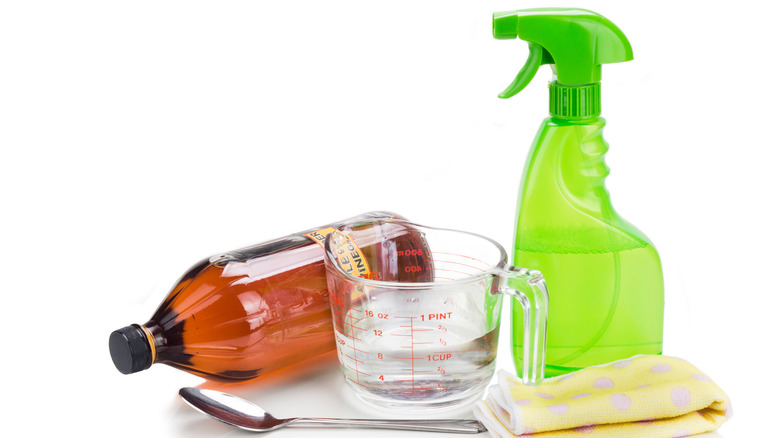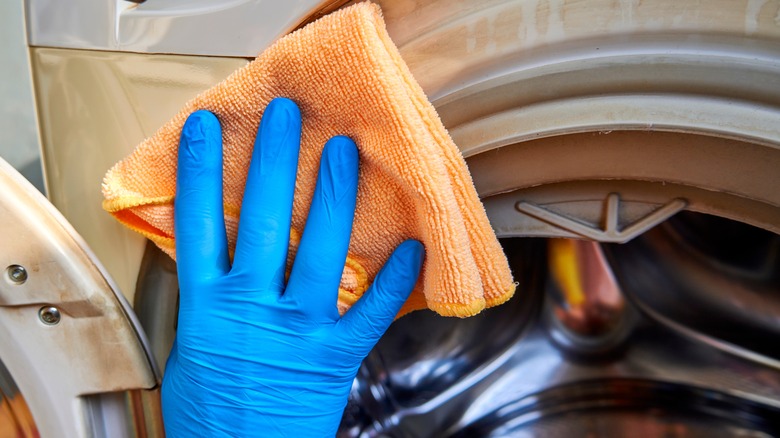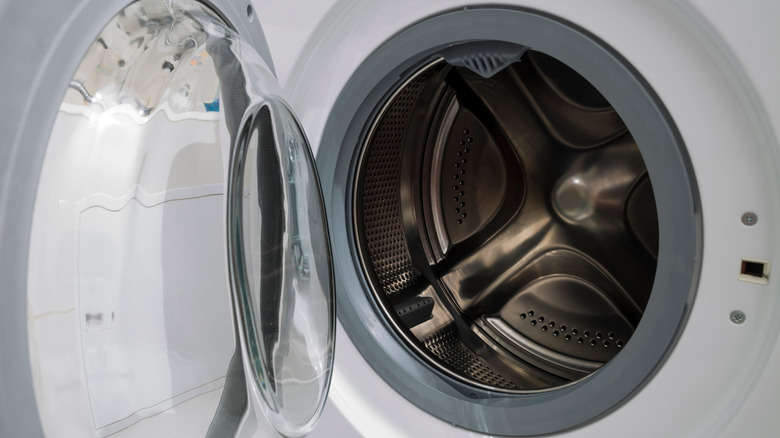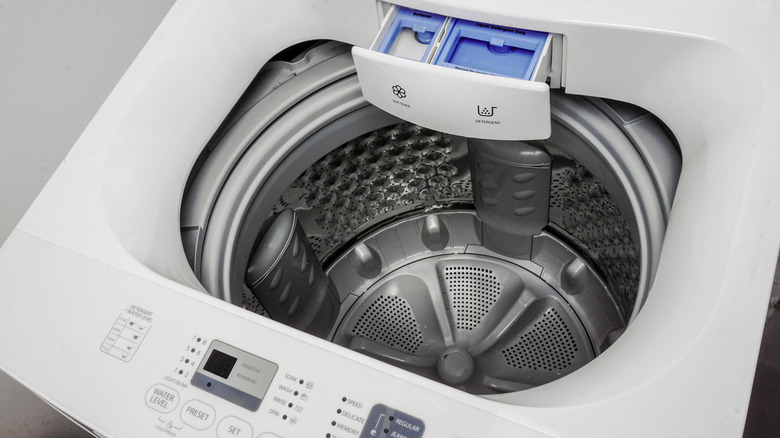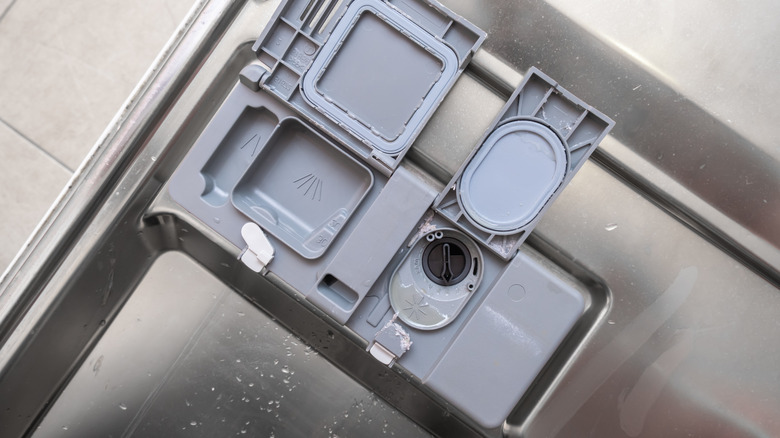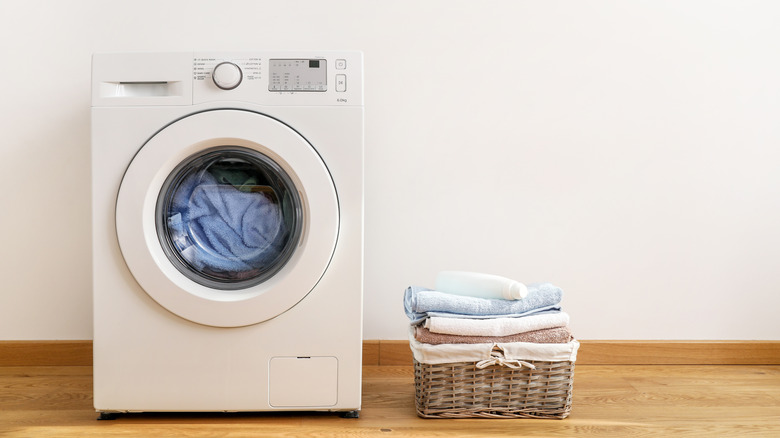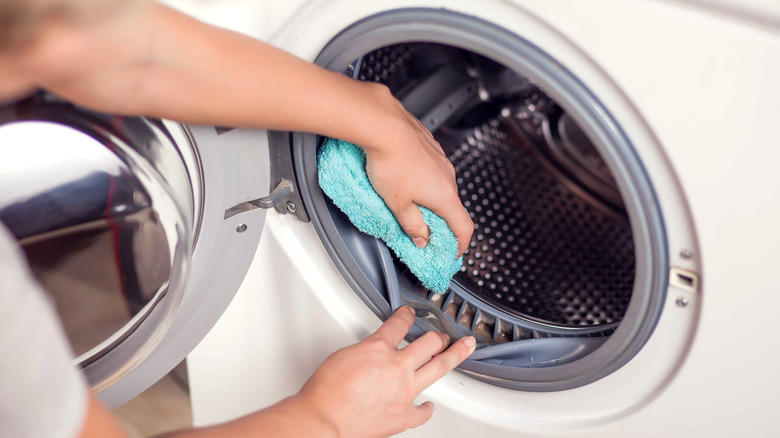The Best Way To Clean Your Washing Machine
From dishes to clothes, the last thing you might think to wash is your washing machine. Laundry detergent runs through it with every use, but mixing soap with water repeatedly accumulates residue that needs periodic maintenance. Every time you wash your clothes, it's an invitation for mold and mildew to arrive. In terms of mold, moisture is the main source of its damaging decay, according to The Spruce. It often shows up in dark, dirty, and damp places. Mold appears green, red, or black and is often fuzzy in texture and appearance. An odor may also be present if it's an extensive matter.
Mildew looks flat and may start out looking white and powdery. With the growth of these bacteria-spreading organisms, you may be putting your health at risk, as mold and mildew can spread through your clothes, causing allergy-like symptoms. The mold found within your washing machine may appear mainly on the round rubber gasket or door seal. This is the first thing you'll want to inspect for cleaning.
Establish a mold removal solution
There are several ways to approach cleaning your washing machine. Establish an effective cleaning solution for your washer that will remove mold. Whether store-bought or a DIY concoction, start with what usually works best for your home appliances. You can also make definite use of standard household cleaners like baking soda, vinegar, and bleach. Keep an all-purpose cleaner and glass cleaner on hand as well. There are various cleaners to utilize, although remember never to mix bleach and vinegar, as this can create a toxic gas.
PuroClean recommends a few different recipes, one of which is mixing 2 cups of water with ¼ cup lemon juice and then mixing in ½ cup distilled white vinegar. If you don't have vinegar on hand, you can mix 2 cups of water with ½ cup hydrogen peroxide and then add ¼ cup lemon juice to the mix. Before starting the cleaning process, make sure there are no clothes present inside your washer. Also, check that no detergent is in the dispenser or drum, including fabric softener.
Wear the proper protection
When exposing yourself to mold and mildew, it's important to take precautions by wearing the right protective gear. Always protect yourself by wearing rubber, water-resistant gloves when cleaning dirt, mold, and debris. Also, guard yourself against inhaling mold spore odors by wearing a face mask. This will keep you from breathing in your cleaning products, which can be strong and harmful when used in great amounts.
To avoid any fumes or bacteria affecting your eyes, utilize protective goggles or safety glasses. According to DoItYourself, make sure the area you're cleaning your washer is well ventilated. Depending on its location in your home, open a window or garage door, turn on a fan, or place the appliance as near to fresh air as possible. If your washer's fungus level is rather extreme, then take short breaks from cleaning, preferably 10 minutes for each 1/2 hour. This will ensure your safety.
Clean the rubber gasket (seal or boot)
The rubber gasket is generally the first place to begin fighting against fungus growth. Depending on the level of mold damage, it may take several attempts. There are various ways to clean the gasket. Wipe down the seal with your preferred cleaner using a lint-free cloth. Make sure to get in between the rubber folds, since mold, mildew, hair, and other small objects may dwell there, too. HomeSteady recommends thoroughly spraying the gasket with a vinegar-water solution, or creating a bleach blend that includes 1 part bleach to 4 parts water. Let it sit for several minutes on the gasket, and then wipe it clean. If you have trouble removing black spots, scrub them with a toothbrush.
You can also try a mixture containing 2 tablespoons of liquid dishwashing detergent with 1 quart of warm water. Scrub the gasket with a brush to remove any residue, and wipe down the washer door glass with an ammonia-free glass cleaner.
How to clean a front-load washing machine
Front-load washing machines tend to be synonymous with mold and mildew issues as well as unwanted smells. Whether you have a front-load washing machine or a top-loading one, the same cleaning products might be used, but the methods are different. To clean your front-loading washer, detoxify the drum by mixing 1 cup of chlorine bleach (or hydrogen peroxide) and 1 cup of baking soda and pour it into the detergent drawer. Make sure the basin is empty. For an advanced clean, add an extra 1 cup of baking soda into the drum, as per Hoover. You can do this several times.
Afterward, wipe down any visible film on the door using a glass cleaner, vinegar-water solution, or try a mixture of water with a few drops of peppermint oil, which is antibacterial. Clean off visible dirt and soap residue throughout the exterior of the washing machine itself. These can easily appear on the edges and the inside flaps of the gasket.
How to clean top-load washing machines
To achieve an in-depth clean with your top-loading machine, put it on the hottest water setting and fill it up as you would usually start a heavy load of laundry. Experts at HGTV recommend pouring 1 quart of bleach into the drum. Make sure there's no clothing or towels inside. Close the lid and let it mix for a minute. Then, stop it and let it sit for up to an hour. When this time has ended, close the lid again and run the cycle in its entirety.
For an additional cleanse, add 1 quart of vinegar next time and repeat the same procedure. Don't miss the opportunity to clean the corners and crevices of the lid and on the interior around the gasket, as noted by The Kreative Life. Wipe down areas with a rag first, then for a deeper clean scrub with an old toothbrush. Also, leave the lid up after each wash. This will help air out the drum and reduce the potential development of mold and mildew, especially if you live in a more humid climate.
How to clean the dispenser drawer
Another significant area to pay attention to is the dispenser drawer. Laundry detergent and fabric softeners are constantly added here, and, with time, their residue accrues, leaving a sticky or crusty mess. It's easier to remove the entire drawer than to clean it while it's still inside the washing machine. Generally, you can locate a small lever to release the drawer, per Hotpoint, but check your washer's manual if you're unsure. If the drawer has additional compartments for bleach or fabric softener, remove and clean them as well.
Rinse and soak all the parts in hot water for 10 minutes; add vinegar if you choose. After this, you can use a small brush to scrub off any scum present (via Downy). Try an antibacterial wet wipe to clean the interior slot. Let all the parts and the drawer air-dry, then put back into place.
Clean the exterior of your washing machine
Whether you have a front-load or top load washing machine, you need to clean the machine's exterior and around its perimeter to have it feel fully tidy. Dirt, dust, and debris often get caught in the edges and should be removed. There's nothing worse than opening a washing machine and seeing strands of hair or lint caught in crevices. Perform a deep clean by spraying and wiping down the top and sides of the machine with a micro-fiber cloth, including knobs and crevices. Again, use your vinegar-water solution or an all-purpose cleaner.
Molly Maid suggests going a step further by washing the control knobs (if removable). Also, if you've been able to move the washer away from the wall, it's a great time to sweep or vacuum behind it. Check any hoses for cracks or wear as well, as this can prevent future potential water damage.
How to prevent mold in your washing machine
Preventing mold accumulation is just as important as removing it. A little thing that may help is leaving the washer door open after each use and wiping out any water. This will assist in preventing new bacteria growth on the interior. Also, be sure to give your washer a deep clean a couple of times a year to maintain its cleanliness, as noted by The Spruce. If a mold problem persists, follow the cleaning steps mentioned within this article each month.
Sometimes rubber gaskets are beyond the cleaning stage and need to be replaced altogether. Look up the model or part number online and/or refer to your owner's manual for assistance. Once you have received your replacement piece, follow the step-by-step instructions on how to remove or change the door gasket on your specific washing machine, per SF Gate. Remember to unplug the washer and possibly turn off the water supply before beginning.
